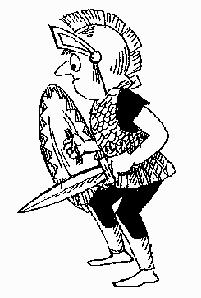|
Warfare was a normal part of Greek Life, and the
city-states frequently fought each other. Many Greek men,
therefore, had to join an army, and from the earliest times
had to pay for their own armour and equipment. In Athens,
boys trained as soldiers between the ages of 18 and 20 after
which they could be called up for military service. In
Sparta, it was much earlier. Athenian soldiers were led by
ten commanders called strategoi. The
infantry soldiers were the backbone of the Greek armies and
they fought in close formations called phalanxes. Poorer
soldiers served in auxiliary units as archers and
stone-slinger. When laying siege to cities, the armies of
Hellenistic Greece used catapults, flame-throwers,
battering-rams, and cauldrons containing burning coals and
sulphur. Athens controlled its empire by means of
oar-powered warships or triremes. At the
height of its power, Athens could rely on about 300
triremes.
|

|